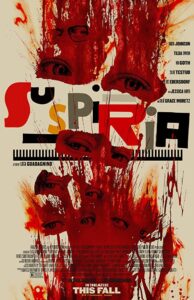The re-imagining of “Suspiria” is weird and, at times, positively revolting, but hardly scary.

 Director Luca Guadagnino may have been the wrong guy to tackle the remake of Dario Argento’s horror classic “Suspiria.” Guadagnino, who last year gave us the wonderful “Call Me By Your Name,” leans heavily into the arty elements of the source material with inconsistent results. This artistic approach yields some interesting images and sequences, including one of the most repulsive kill scenes I’ve ever watched, but, as a whole, the film is a failure.
Director Luca Guadagnino may have been the wrong guy to tackle the remake of Dario Argento’s horror classic “Suspiria.” Guadagnino, who last year gave us the wonderful “Call Me By Your Name,” leans heavily into the arty elements of the source material with inconsistent results. This artistic approach yields some interesting images and sequences, including one of the most repulsive kill scenes I’ve ever watched, but, as a whole, the film is a failure.
The narrative has a young American dancer named Susie Bannion (a very good Dakota Johnson), traveling to Berlin in the 1970s to join a dance school run by Madame Blanc (Tilda Swinton). The school is really a front for a coven of witches. The naive Susie might be part of some kind of master plan. She’s escaped a puritanical, religious household in America to follow her dream of dance in Europe. And when she does perform, she instantly captures the imagination of the head mistress Madame Blanc. Their connection is instantly intriguing and, perhaps, even sexual, however, this element is only teased.

Meanwhile, Patricia (Chloë Grace Moretz), one of the school’s former dancers, is being treated by Dr. Josef Klemperer (also played by Swinton in heavy costume and makeup) for what might be a delusion disorder. But Dr. Klemperer isn’t so sure that Patricia’s delusions are all just in her head. She drops in and out of the story, as if she’s a spirit. It’s frustrating.

The 1977 original “Suspiria” was an odd one, featuring strange over-dubbing, a heavy synth score, a laughably, but potent, bad puppet bat attack, creepy characters, an attic crawling with maggots, and sumptuous, vivid production design. That film has a terribly dated ending, but one that made some sense. Guadagnino’s version, by contrast, is an indecipherable rewrite by David Kajganich, who’s next writing the new “Pet Sematary.” The bloody conclusion is ludicrous.
What really pains me about Guadagnino’s version is that it just isn’t scary. Regardless whether Argento’s now cheesy and dated effects pull you out of the narrative, there are terrifying moments in his film. And the strange sound design, that may have been an accident given the dubbing involved, gave the entire production an other-worldly feeling. While Guadagnino gets the bizarre facets down, he isn’t really able to make them frightful.

An example is that in the original film, there was a killer on the loose, as I remember it. The first kill scene is really terrifying. And it puts the viewer on edge—instant tension, as a young woman is slashed and falls to her death. That story thread has been pulled from this remake, in favor of more supernatural themes and political ones.
Without much explanation, Kajganich’s screenplay mixes in a terrorism subplot that has only tangental importance. It’s almost a Hitchcockian MacGuffin. However, since this subplot is given constant prominence, it makes the fatal error of running afoul of Anton Chekhov’s famous advice: “If in the first act you have hung a pistol on the wall, then in the following one it should be fired. Otherwise don’t put it there.” I’m not saying that Guadagnino needed to wind things up with a terrorist bomb going off. But the terrorism aspects he does include only act to distract and are one of the exasperating threads left hanging.

Swinton plays three characters in the movie. I’m not sure why this was really necessary. Because we know that she’s playing Dr. Klemperer, the whole thing seems like some kind of elaborate gag. And it doesn’t even connect—the characters aren’t somehow linked in the overall story. I can’t imagine that casting one actor and then going through the substantial effort to hide her under mounds of makeup and prosthetics made sense in the budget either. My thought was that casting someone like Jeremy Irons would have been a far better fit for Klemperer. I’m sure that I’m missing something, but I just didn’t get it.
And I don’t think that Guadagnino gets why the original “Suspiria” worked in the first place. It was, at its heart, an arty film, but also one that was a part of a horror/thriller genre that Argento had helped to pioneer. He was a prominent contributor to Giallo cinema. But aside from the title, the dance school, character names, and the coven of witches, Guadagnino, working from Kajganich’s way too busy script, ignores the genre foundations that made the original so important, but, also, so much fun.

This new “Suspiria” might be lurid, but it isn’t exploitive, which was integral back in 1977. Notably missing from this film is any real sexuality, which given the setup, seemed to be a logical element. Perhaps, given the current climate, avoiding more overt sexual themes is understandable, but this is a remake of a Dario Argento film. One would think that sex would have played a more prominent role. Instead, there’s politics and witchcraft. And ultimately, as socially aware as Guadagnino wants his film to be, it just comes off as laughably self-important. Trying to explain or describe the movie would produce a room full of eye-rollers.

The production design here is a real downer. Surprising is that the 1977 film looks far better. Argento’s rich use of colors, particularly red, and his meticulous attention to detail is one of the film’s lasting high points. Guadagnino, working with his “Call Me By Your Name” cinematographer Sayombhu Mukdeeprom, gives us a drab and really ugly looking collection of images. By the time the story reaches its action packed conclusion, the visuals are impossibly smeary and dull, with blood looking brownish, although flowing in fountains. It’s suitably distasteful, but impossible to admire. And the action is delivered in blurry slow motion that has little impact, other than to further frustrate the viewer.
“Suspiria” 2018 is not a horror film, although it borrows from the genre. But even as a dramatic art film it does not succeed.
